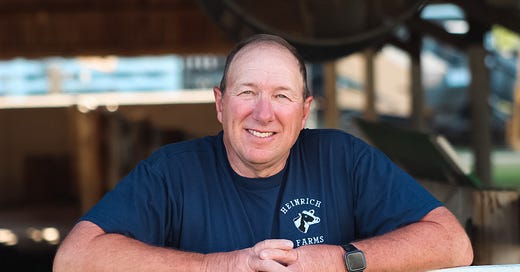VIEWPOINT: Carbon capture the right path forward for South Dakota
Guest op-ed by Joe Heinrich
Over the last year, we have seen carbon capture technologies in the headlines. Most recently, there have been multi-day permit hearings underway with the South Dakota Public Utilities Commission in Fort Pierre over a proposed pipeline project. As a lifelong farmer and agricultural advocate, I appreciate the questions some have surrounding carbon transportation.
Our farm has been in our family for 150 years. For generations, our livelihood has depended on protecting our land and we have honored those family traditions, while also understanding the value of innovation for the growth of our farm and community.
As Executive Director of the Smart Carbon Network, I have been traveling throughout the Midwest to speak with property owners, local farm associations, elected officials, and more about carbon capture pipelines – an innovative method of carbon management that will bring lasting economic benefits to farmers and rural communities across the country. In my various conversations, I noticed a few reoccurring questions arise. What does carbon capture mean for landowner rights? Is this technology safe for our communities? What does the future of farming look like with carbon capture in my region? It is my hope that I can shed some light on these questions and help my fellow farmers understand the immense benefits carbon capture can bring to South Dakota.
Being a farmer myself, I recognize how critically important the preservation of land and protection of property owner rights are to South Dakota communities. Which is why I am pleased to share that responsible project operators also recognize the importance of these matters as well. When implementing a new carbon capture project in South Dakota, responsible operators actively seek out opportunities to work directly with landowners to ensure they are the best neighbors and community partners they can be. Operators want to collaborate with local areas, so they fully capture the concerns and interests of the community and act accordingly. Collaboration with property owners helps operators better understand the community’s needs, such as completing construction in an efficient and timely manner to avoid potential disruptions and restoring the land to as close to its original condition as possible. Even after a project is complete, responsible operators continue their partnership by closely monitoring the quality and safety of the pipeline for South Dakota’s land and people. Thankfully, for over 50 years, carbon capture projects have had an extremely strong safety record due to their strict regulations and monitoring.
The U.S. has been transporting liquid CO2 via pipeline since the 1970s and that infrastructure has grown to more than 5,500 miles in operation today. In fact, CO2 pipelines are the most common method of transporting large quantities of CO2 – and compared to truck or rail, are safer and more efficient. Carbon pipelines are monitored by operators 24 hours a day, 7 days a week, 365 days a year. Operators proactively conduct inspections and regular maintenance checks to promptly identify and address any potential issues. Furthermore, all pipelines are subject to regular inspections by the Pipelines and Hazardous Materials Safety Administration (PHMSA) as the federal regulator. PHMSA maintains safety oversight and regulations for CO2pipelines across the country – old and new. Additionally, the U.S. Environmental Protection Agency (EPA) enforces strict regulations over the siting, operating, testing, and long-term maintenance of injection wells, where the CO2 can be permanently secured deep underground. Suffice to say, these comprehensive safety measures are set in place to ensure the safety of the pipeline for our communities and for our farmland.
Carbon capture management technology is a unique opportunity for South Dakota’s farms and local communities to usher in a new era of sustainable innovation alongside significant economic growth. A leading producer of U.S. ethanol, South Dakota plays a key role in fueling our country, which keeps the state’s farmers’ corn in high demand. As the nation’s demand for lower-carbon fuel sources grows, carbon capture technology will help put ethanol into the spotlight as a viable low-carbon biofuel – and as ethanol demand increases, so will the need for corn. The expansion of carbon capture projects will contribute to the livelihoods of friends, families and neighbors, and the economic prosperity of local communities in the short- and long-term.
According to a study conducted by the Dakota Institute, researchers concluded that the adoption of carbon capture in South Dakota could generate approximately $6 billion in economic growth. Additionally, researchers found that increasing ethanol production with carbon capture by 15 percent would drive demand for an additional 77 million bushels of corn annually – increasing the value of corn by $123.46 million. And if that’s not enough, the study also concluded that carbon capture can grow income for farmers by $192 million. Carbon capture is and will continue to be an important asset to South Dakota’s people and economy.
All in all, carbon capture technology is a safe, smart, and innovative way to ensure the short- and long-term viability of South Dakota’s farms, communities, and land. By embracing carbon capture technology together, we can secure a more sustainable and prosperous future for our friends, family, neighbors, and future generations of South Dakotans.
Joe Heinrich is a farmer, landowner, and the Executive Director of the Smart Carbon Network.






Really never explains the how, why, where, and when of CO2 capture...except that it pays $$$ to the ethanol industry...
Propaganda?